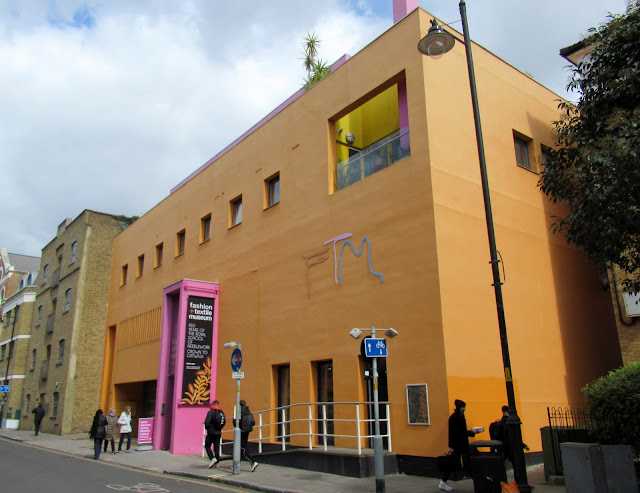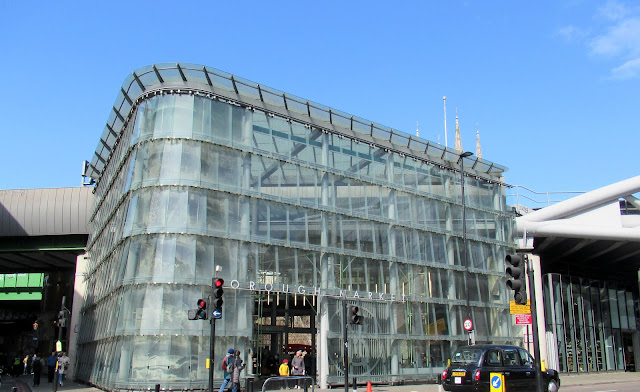We spent a day in London last week. We started with the Isamu Nogushi exhibition at the White Cube gallery in Bermondsey.
After the exhibition we left the gallery and started walking towards Tate Modern intending to see the Surrealism without Borders exhibition.

We walked along Bermondsey Street - a walk which I always find very pleasant:

there's lots of interesting eateries here and some good shops for window-shopping.
This little park

is the home of
Cornerstone, a sculpture created through the collaboration of sculptor Austin Emery and over a hundred members of the community: adults and children carved the individual pieces of this sculpture which were then unified by Emery - a wonderful, unifying community venture.
The area is full of converted warehouses
We continued along Bermondsey Street and got our first glimpse of the Shard
with frequent stops to look at the windows of interesting shops
eateries and pubs.
like the Giddy Grocer.

Past Zandra Rhodes' Fashion and Textile Museum - we wanted to go in, but were aware of time so we moved on to
Peter Layton's Glass Blowing gallery. We did stop here, post to follow.
Lots of pubs with interesting outside seating areas
We turned left into St Thomas Street, Tower Bridge Station on our right, and the Shard next to it
A tower of glass, the Shard was designed by Renzo Piano. The 72-storey skyscraper stands at 309.6 metres and is the tallest building in the UK. It has 72 habitable floors with a viewing gallery and open-air observation deck on the 72nd floor.
Piano designed The Shard as a spire-like sculpture emerging from the river Thames. He was inspired by the railway lines next to the site, the London spires depicted by the 18th century Venetian painter Canaletto and the masts of sailing ships. Piano's design met criticism from English Heritage, who claimed the building would be 'a shard of glass through the heart of historic London', giving the building its name. Piano considered the slender, spire-like form of the tower a positive addition to the London skyline, recalling the church steeples featured in historic engravings of the city, and believed that its presence would be far more delicate than opponents of the project alleged. He was right.
A view of the building as we left it behind us.
Our next stop was the Borough Market.
Medieval Southwark was London's first suburb, clustered round the southern end of London Bridge, London's only bridge over the Thames from Roman times until 1750 and thus, the only route south. London Bridge was the most obvious place for the Kent farmers to sell their goods to the city grocers, and there's been a thriving market hereabouts since medieval times. The present Borough Market is squeezed beneath the railway arches between the High Street and Southwark Cathedral. It's one of the few wholesale fruit and vegetable markets still trading under its original wrought-iron shed, though now it's undergone a transformation from scruffy obscurity to a small foodie haven.
As I mentioned earlier the market is squeezed beneath the railway arches. In 1836, the Londn and Greenwich Railway - the city's first - was built through the district, supported by 878 brick arches stretching for four miles.
Teeming riverside wharves and overcrowded tenements brought some of the worst social conditions in Victorian London as Charles Kingsley discovered: 'Oh God! What I saw! People having no water to drink but the water of the common sewer which stagnates full of ... dead fish, cats and dogs'.
Things are very different today, and this fruit stall sells the freshest-looking fruit and veg
This guy was making and selling wild mushroom risotto
The fish looked extremely fresh
while the lobsters were alive and kicking
It was an extremely cold day
yet people were sitting all around the market eating
We eventually left the market and started walking along Southwark Street on our way to Tate Modern.
The sculptures of three musicians climbing up this building is innovative and fun
We arrived at the Tate, enjoyed our lunch in the Members' Room and then went to see the
Surrealism Without Borders exhibition.








































No comments:
Post a Comment